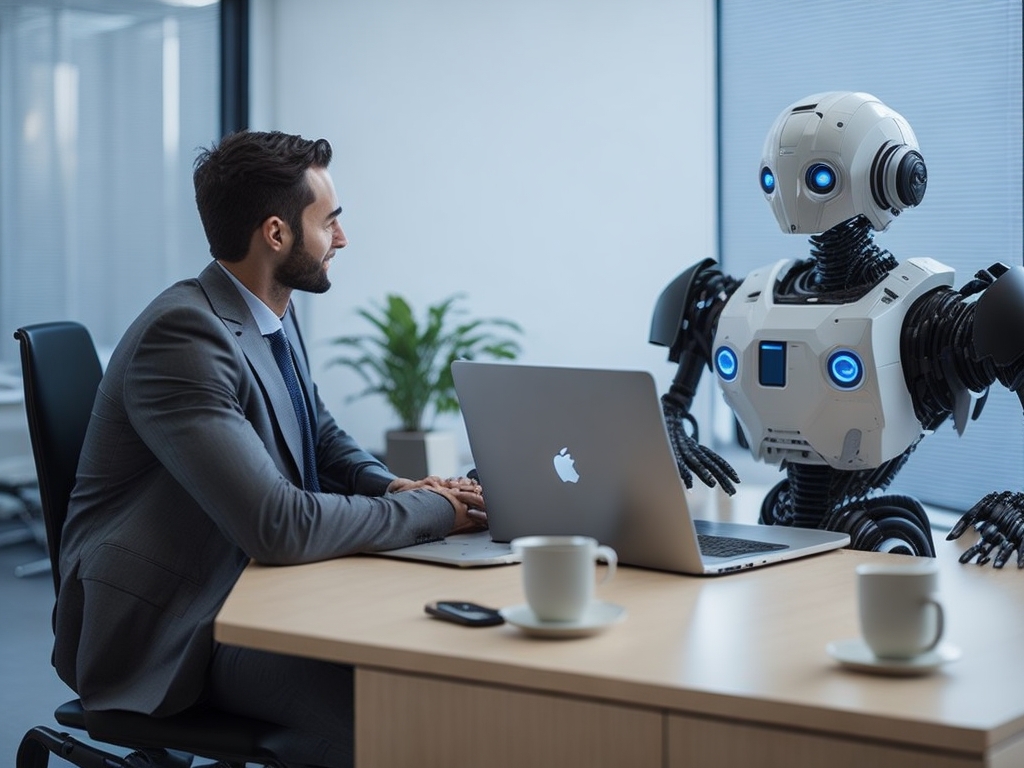Introduction
In the rapidly evolving digital age, artificial intelligence (AI) has permeated various sectors, including the realm of employment. While AI has streamlined many processes, it has also raised concerns about potential employment discrimination. This blog post will delve into this critical issue, drawing insights from two recent articles: “Preventing Employment Discrimination in the Age of AI: EEOC Offers Guidance” from Hyderally & Associates P.C. and “AI Discrimination in Hiring, and What We Can Do About It” from New America. These articles shed light on the role of AI in hiring processes, the potential for discriminatory practices, and the steps being taken to address these concerns.
In the next sections, we will explore the U.S. Equal Employment Opportunity Commission’s (EEOC) response to AI in hiring, the prevalence and impact of AI in hiring, the role of bias in AI hiring tools, the need for regulation and transparency, and finally, provide advice for job seekers navigating this landscape.
Stay tuned as we delve into the intricacies of employment discrimination in the age of AI.
The EEOC’s Response to AI in Hiring
The EEOC, recognizing the potential for AI tools to result in employment discrimination, has taken proactive steps to address this issue. As highlighted in the article by Hyderally & Associates P.C., the EEOC recently published a technical assistance document titled “Assessing Adverse Impact in Software, Algorithms, and Artificial Intelligence Used in Employment Selection Procedures Under Title VII of the Civil Rights Act of 1964” [1].
These guidelines, released on May 18, 2023, aim to prevent employment discrimination against job seekers and workers. They are part of the EEOC’s ongoing effort to ensure that the use of new technologies complies with federal EEO law. The EEOC is educating employers, employees, and other stakeholders about the application of these laws to the use of software and automated systems in employment decisions [1].
Title VII of the Civil Rights Act of 1964 prohibits employment discrimination based on race, color, religion, sex, or national origin. It prohibits both intentional “disparate treatment” of employees and employment practices which have a “disparate impact” or “adverse impact” on employees based on these protected classes. The EEOC’s guidelines warn that different types of AI used to evaluate candidates in the employment process could unintentionally result in “disparate impact” discrimination [1].
The EEOC’s ongoing monitoring of the potential for employment discrimination arising from the use of AI in the employment process, and publication of guidelines which define when AI can constitute disparate impact discrimination, is a significant step towards ensuring fair hiring practices in the age of AI.
EEOC’s Initiative on AI and Algorithmic Fairness
In 2021, the U.S. Equal Employment Opportunity Commission (EEOC) launched an initiative to address the potential for discrimination in the use of software, including AI and machine learning, in hiring and employment decisions. The EEOC aims to ensure compliance with federal civil rights laws and guide employers, employees, job applicants, and vendors in using these technologies fairly and consistently.
Through the initiative, the EEOC will closely examine how existing and emerging technologies impact employment decisions. They will issue guidance on algorithmic fairness, identify best practices, engage stakeholders through listening sessions, and gather information on the adoption and impact of hiring technologies. This comprehensive approach aims to promote fairness and compliance with equal employment opportunity laws in the use of AI and related technologies.
The Prevalence and Impact of AI in Hiring
AI’s role in hiring processes has become increasingly prevalent. As noted in the New America article, by 2020, 55% of hiring managers in the U.S. were using algorithmic software and AI tools in their recruitment process [2]. These tools, while efficient, can inadvertently lead to employment discrimination, affecting various groups, including people of color, women, and people with disabilities.
The discriminatory hiring that can result from the use of AI inevitably hurts these groups and society as a whole. Improved employment outcomes for members of these groups increase overall wages and boost economic growth. However, the use of AI in hiring processes can inadvertently create barriers for these groups, leading to employment discrimination [2].
The rise of AI in hiring has coincided with significant shifts in the labor market, including the “Great Resignation,” where four million people willingly quit their jobs in April 2021. As the future of work remains uncertain, the need for a streamlined hiring process becomes even more critical. However, it is equally important to ensure that this process is free from employment discrimination [2].
The Role of Bias in AI Hiring Tools
AI hiring tools, while designed to streamline the recruitment process, can inadvertently introduce bias, leading to employment discrimination. This bias can manifest in various ways, including through gendered language and racial discrimination.
Research suggests that women often downplay their skills on resumes, while men often exaggerate and include phrases tailored to the position—making their resumes stand out to an algorithm [2]. This can put female applicants at a disadvantage, replicating the gendered ways in which hiring managers judge applicants. Furthermore, job descriptions are often flooded with gendered language, which can further perpetuate this bias [2].
Racial discrimination is another form of bias that can be perpetuated by AI hiring tools. A 2021 economic study found evidence of racial discrimination in present-day hiring processes. Applications submitted with distinctively Black names were less likely on average to receive a response compared to applications with distinctively white names [2].
Moreover, AI hiring tools can also disadvantage individuals with disabilities. Certain hiring practices, like personality tests, AI-scored video interviews, and gamified assessments, fail to consider individuals who may need accommodations. This can result in employment discrimination against these individuals, violating the Americans with Disabilities Act [2].
The Need for Regulation and Transparency
Given the potential for AI hiring tools to result in employment discrimination, there is a pressing need for regulation and transparency. Several legislative efforts are underway to address this issue.
D.C. Attorney General Karl Racine announced a bill banning algorithmic discrimination at the end of 2021. Additionally, U.S. Senators Ron Wyden and Cory Booker, along with Representative Yvette Clarke, introduced the Algorithmic Accountability Act of 2022. This bill would require companies to conduct “impact assessments” scanning systems for bias, effectiveness, and other factors when using AI to make key decisions related to employment, loans, and even housing applications. It also proposes the creation of a public repository at the Federal Trade Commission to track and monitor these systems [2].
However, legislation alone is not enough. Companies need to be more transparent about their use of AI in hiring. They should publish detailed policies that allow consumers to understand how a company uses algorithmic systems and for what purposes. In addition, companies should describe how they use personal data to train and inform systems—while providing users with the opportunity to opt out of using algorithmic systems [2].
Advice for Job Seekers
In the face of potential employment discrimination due to AI hiring tools, job seekers can take certain steps to navigate this landscape more effectively.
Firstly, job seekers should tailor their resumes to match job descriptions, list their skills, use action-oriented words, and include quantitative details. This can help their resumes stand out to AI hiring tools [2].
Secondly, job seekers should consider the format of their resumes. Most career coaches recommend submitting a Microsoft Word or PDF file, especially for positions that don’t require design or visual skills. A basic format may be more easily read by applicant tracking systems (ATS) [2].
Job seekers can also try to detect whether a company uses ATS by looking for branding on the website or checking the web domain of an online application for the name of an ATS program [2].
Finally, job seekers should not hesitate to report companies that use discriminatory hiring practices. Achieving equitable employment outcomes and driving social and economic mobility starts with deconstructing technological barriers that deny job seekers a fair shot at success [2].
Conclusion
In conclusion, the use of AI in hiring processes, while efficient, can lead to employment discrimination. This issue affects various groups, including people of color, women, and people with disabilities. Both the EEOC and various legislative efforts are working to address this issue, aiming to ensure that AI hiring tools comply with federal EEO law and other civil rights laws.
However, there is still much work to be done. Companies need to be more transparent about their use of AI in hiring and should continuously assess their tools for potential bias. Job seekers, on the other hand, can take steps to navigate this landscape more effectively, such as tailoring their resumes to match job descriptions and reporting companies that use discriminatory hiring practices.
As we move forward, it is crucial that we continue to monitor the use of AI in hiring and work to prevent employment discrimination. The goal should always be to ensure fair hiring practices that respect the rights of all job seekers.
References:
[1] Foner, F., & Hyderally, Ty. (2023). Preventing Employment Discrimination in the Age of AI: EEOC Offers Guidance. Hyderally & Associates P.C. Retrieved from https://www.employmentlit.com/2023/06/07/preventing-employment-discrimination-in-the-age-of-ai-eeoc-offers-guidance/
[2] New America. (2023). AI Discrimination in Hiring, and What We Can Do About It. Retrieved from https://www.newamerica.org/oti/blog/ai-discrimination-in-hiring-and-what-we-can-do-about-it/




